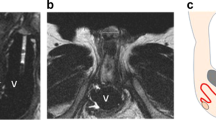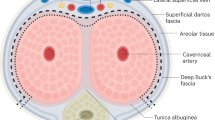Abstract
Exstrophy-epispadias complex (EEC) is a spectrum of genitourinary malformations that ranges in severity and affects external genitalia and the lower urinary tract. The aim of this study was to determine the long-term sexual outcomes of patients with EEC. Sexual outcomes were hypothesized to be related to those of urinary ones. A retrospective database including all patients with EEC who had surgery at a tertiary referral institution from 1990 to 2019 was created. Data based on patient’s charts were collected: demographics, surgeries, sexual outcomes, urinary outcomes. Fifty-eight patients with EEC had surgery at tertiary referral institution and entered our database. For this analysis of sexual outcomes, a sub-set of the whole population was selected: patients being 14 years old and older, having at least one surgery at our institution and having at least 12 months of follow-up. Applying this selection criteria to our database resulted in a series of 29 patients. High rates of sexual activity were observed in pubertal and post-pubertal men (96%) and women (75%). Seventy-nine percent of men and 67% of women reported sexual satisfaction; 63% of men reported normal ejaculation. To achieve these rates, 96% of men required surgery (84% penoplasty, 52% phalloplasty), and 25% of women required introitoplasty. Fertility was achieved in 67% of men and 100% of women. Assisted reproductive technology was needed in one man. Continence rates were high (diurnal continence in 83% and nocturnal continence in 93%). However, 76% required multiple continence procedures. Men and women with EEC can have good long-term sexual and urinary outcomes, but this may require multiple surgeries. Good sexual outcomes seem to be related to good urinary and continence outcome.
This is a preview of subscription content, access via your institution
Access options
Subscribe to this journal
Receive 8 print issues and online access
$259.00 per year
only $32.38 per issue
Buy this article
- Purchase on Springer Link
- Instant access to full article PDF
Prices may be subject to local taxes which are calculated during checkout
Similar content being viewed by others
References
Jayachandran D, Bythell M, Platt MW, Rankin J. Register based study of bladder exstrophy-epispadias complex: prevalence, associated anomalies, prenatal diagnosis and survival. J Urol. 2011;186:2056–60.
Wood D, Baird A, Carmignani L, De Win G, Hoebeke P, Holmdahl G, et al. Lifelong congenital urology: the challenges for patients and surgeons. Eur Urol. 2019;75:1001–7.
Woodhouse CR, Neild GH, Yu RN, Bauer S. Adult care of children from pediatric urology. J Urol. 2012;187:1164–71.
Bower WF, Christie D, DeGennaro M, Latthe P, Raes A, Romao RL, et al. The transition of young adults with lifelong urological needs from pediatric to adult services: an international children’s continence society position statement. Neurourol Urodyn. 2017;36:811–9.
Zhu X, Klijn AJ, de Kort LMO. Urological, sexual and quality of life evaluation of adult patients with exstrophy-epispadias-complex: long-term results from a Dutch cohort. Urology. 2020;136:272–7. https://doi.org/10.1016/j.urology.2019.10.011.
Mendelson D. The European Union General Data Protection Regulation (EU 2016/679) and the Australian My Health Record Scheme – a comparative study of consent to data processing provisions. J Law Med. 2018;26:23–38.
Ganesh A, Gupta NJ, Chakravarty B. Surgical correction of rare Mullerian anomalies and spontaneous pregnancies: a case report. Fertil Steril. 2008;89:723. e13–6.
Lemack GE, Zimmern PE. Predictability of urodynamic findings based on the Urogenital Distress Inventory-6 questionnaire. Urology. 1999;54:461–6.
Castagnetti M, Tocco A, Capizzi A, Rigamonti W, Artibani W. Sexual function in men born with classic bladder exstrophy: a norm related study. J Urol. 2010;183:1118–22.
Ebert A, Scheuering S, Schott G, Roesch WH. Psychosocial and psychosexual development in childhood and adolescence within the exstrophy-epispadias complex. J Urol. 2005;174:1094–8.
Reynaud N, Courtois F, Mouriquand P, Morel-Journel N, Charvier K, Gerard M, et al. Male sexuality, fertility, and urinary continence in bladder exstrophy-epispadias complex. J Sex Med. 2018;15:314–23.
Baumgartner TS, Lue KM, Sirisreetreerux P, Metzger S, Everett RG, Reddy SS, et al. Long-term sexual health outcomes in men with classic bladder exstrophy. BJU Int. 2017;120:422–7.
Garaffa G, Spilotros M, Christopher NA, Ralph DJ. Total phallic reconstruction using radial artery based forearm free flap phalloplasty in patients with epispadias-exstrophy complex. J Urol. 2014;192:814–20.
Woodhouse CR. Prospects for fertility in patients born with genitourinary anomalies. J Urol. 2001;165:2354–60.
Park W, Zwink N, Rosch WH, Schmiedeke E, Stein R, Schmidt D, et al. Sexual function in adult patients with classic bladder exstrophy: a multicenter study. J Pediatr Urol. 2015;11:125. e1–6.
Ben-Chaim J, Jeffs RD, Reiner WG, Gearhart JP. The outcome of patients with classic bladder exstrophy in adult life. J Urol. 1996;155:1251–2.
Gobet R, Weber D, Renzulli P, Kellenberger C. Long-term follow up (37–69 years) of patients with bladder exstrophy treated with ureterosigmoidostomy: uro-nephrological outcome. J Pediatr Urol. 2009;5:190–6.
Mesrobian HG, Kelalis PP, Kramer SA. Long-term followup of cosmetic appearance and genital function in boys with exstrophy: review of 53 patients. J Urol. 1986;136:256–8.
Rubenwolf P, Thomas C, Thuroff JW, Stein R. Sexual function and fertility of women with classic bladder exstrophy and continent urinary diversion. J Urol. 2016;196:140–5.
Salem HK, Eisa M. Long-term follow-up (18−35 years) of male patients with history of bladder exstrophy (BE) repair in childhood: erectile function and fertility potential outcome. J Sex Med. 2012;9:1466–72.
Ansari MS, Cervellione RM, Gearhart JP. Sexual function and fertility issues in cases of exstrophy epispadias complex. Indian J Urol. 2010;26:595–7.
Deans R, Banks F, Liao LM, Wood D, Woodhouse C, Creighton SM. Reproductive outcomes in women with classic bladder exstrophy: an observational cross-sectional study. Am J Obstet Gynecol. 2012;206:496. e1–6.
Dy GW, Willihnganz-Lawson KH, Shnorhavorian M, Delaney SS, Amies Oelschlager AM, Merguerian PA, et al. Successful pregnancy in patients with exstrophy-epispadias complex: a University of Washington experience. J Pediatr Urol. 2015;11:21. e1–6.
Maruf M, Manyevitch R, Michaud J, Jayman J, Kasprenski M, Zaman MH, et al. Urinary continence outcomes in classic bladder exstrophy: a long-term perspective. J Urol. 2019. https://doi.org/10.1097/JU.0000000000000505.
Frimberger D, Gearhart JP, Mathews R. Female exstrophy: failure of initial reconstruction and its implications for continence. J Urol. 2003;170:2428–31.
Neijenhuijs KI, Holtmaat K, Aaronson NK, Holzner B, Terwee CB, Cuijpers P, et al. The international index of erectile function (IIEF)—a systematic review of measurement properties. J Sex Med. 2019;16:1078–91.
Neijenhuijs KI, Hooghiemstra N, Holtmaat K, Aaronson NK, Groenvold M, Holzner B, et al. The female sexual function index (FSFI) – a systematic review of measurement properties. J Sex Med. 2019;16:640–60.
Lim R, Liong ML, Lim KK, Leong WS, Yuen KH. The minimum clinically important difference of the international consultation on incontinence questionnaires (ICIQ-UI SF and ICIQ-LUTSqol). Urology. 2019;133:91–5.
Acknowledgements
The Ghent University Hospital’s Department of Urology is accredited by the European Reference Network (ERN) in the eUrogen sub-section (urologic rare diseases), specifically for the EEC complex, making the Department a European referral center.
Funding
This reasearch was funded by Research Fund for Pediatric Urology ‘Gianni Eggermont fonds ter bevordering van de kinderurologie’.
Author information
Authors and Affiliations
Corresponding author
Ethics declarations
Conflict of interest
The authors report no conflict of interests. All data are available at all times by request to the corresponding author, according to GDPR and Ethics rules.
Additional information
Publisher’s note Springer Nature remains neutral with regard to jurisdictional claims in published maps and institutional affiliations.
Rights and permissions
About this article
Cite this article
Sinatti, C., Waterschoot, M., Roth, J. et al. Long-term sexual outcomes in patients with exstrophy-epispadias complex. Int J Impot Res 33, 164–169 (2021). https://doi.org/10.1038/s41443-020-0248-2
Received:
Revised:
Accepted:
Published:
Issue Date:
DOI: https://doi.org/10.1038/s41443-020-0248-2



